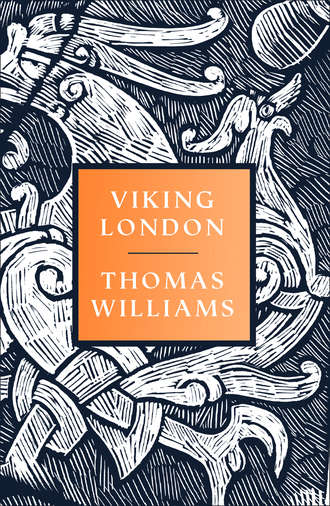
Полная версия
Viking London
In the peace that followed Edington (and the so-called Treaty of Wedmore), Alfred extracted from his erstwhile foe a number of key concessions, including his baptism and an agreement to change his name from Guthrum to Æthelstan. The key part of the whole ritualized encounter seems to have been – from Alfred’s perspective at least – the acceptance by Guthrum-Æthelstan of a symbolic filial subordination: he became, in the process of baptism, Alfred’s godson. It was a tacit acceptance of Alfred’s overlordship – an agreement to be his man. And though it might seem from a West Saxon perspective like total victory – a heathen warrior humbled, forced to his knees to kiss the cross and the ring of his conqueror – in reality it is hard to believe that Guthrum received nothing in return, that his defeat had been so total that it warranted nothing but humiliation.
Instead it seems likely that the negotiations included the recognition of Guthrum-Æthelstan as king of East Anglia – albeit a king who owed notional fealty to Alfred as his ‘father’ and overlord. Certainly, when the two men next met, it was perceived as a royal summit: the so-called Treaty of Alfred and Guthrum styles both men as ‘rex’. Amongst other provisions, that treaty – which is broadly datable to somewhere between 878 and Guthrum’s death in 890 – defined the respective spheres of influence of both kings. The dividing line was to be a boundary that ran ‘up the Thames, and then up the Lea, and along the Lea to its source, then in a straight line to Bedford, then up the Ouse to Watling Street’. It was a treaty which conspicuously, and with obvious deliberation, scored a boundary around London, keeping it tucked just within the limits of Alfred’s authority.
Today the River Lea empties out into the Thames in Poplar, just east of the Isle of Dogs. To walk its course upriver is to pass through Stratford and past Hackney Marshes to Tottenham, Edmonton, Walthamstow, the river filling the Lea Valley reservoir chain, Epping Forest stretching away to the east. Its path carves through the Olympic Park, the ‘Olympicopolis’ so despised by Iain Sinclair: a ‘city of pop-ups, naming rights, committee-bodged artworks, cash-cow academies, post-truth blogs and charity runs’, an ‘emerging digital conceit on the Viking bank of the River Lea’.3 Sinclair seems at times unmoored by despair, enraged by the changes wrought by corporate money and empty technocracy on the cherished, untidy banks of the river. During construction of the Olympic Park he beat like an angry wasp against the notorious blue fence that enclosed the development, body and rhetoric levelled against the barrier. After Olympicopolis inevitably shimmered into three dimensions, he railed at this ‘theme park still to identify its theme’, still ‘waiting on input from a content provider’.4
Alfred, I am sure, would have approved of the Olympic Park; he emerges from the sources as a lover of order, a man didactic in his inclinations, managerial in style. He admired the Romans, planned grand building projects, enjoyed a good right-angle. I imagine he would have agreed that cleanliness is next to godliness. The world he and his scribes envisaged was a place of order and easy management, of binary choices and simple ethnicities: English, Danish; Christian, Heathen; Good, Bad. There were no shades of grey in Alfred’s little England, no room for conflicted loyalties, identities or beliefs: those things were chaos, and chaos lived beyond the pale in fifelcynnes eard – in ‘monster world’.5 In the ninth century, it was the slow drift of the Lea that became the limes, the tear in the fabric that separated Alfred’s ‘Anglo-Saxon’ realm from another place – a world of confused allegiances and sundered bonds, where the alien Guthrum reigned as king of East Anglia and a host of unnamed Viking warlords and embattled Anglo-Saxon thegns struggled to make sense of a disordered world.
In truth, it is hard to imagine how this boundary was ever inscribed in reality – there were no ramparts, no watchtowers. No wall. Even within the city, the lines of authority were blurred, a messy West Saxon/Mercian compromise involving Kentish and Mercian bishops and the shadow of the new Scandinavian regime in East Anglia.fn1 As a notional approximation of the length of Alfred’s reach, the treaty placed London at the very tips of his outstretched fingers, barely within his grasp.
Perhaps it was this sense of insecurity that informed the tenor of what is perhaps the most famous of all mentions of London to emerge from the Anglo-Saxon Chronicle, the record of a moment that has taken on an almost mythic status in the history of the city and of the nation, the moment in 886 when ‘King Alfred restored [gesette] fortress London [Lundenburh], and all the English [Angelcyn] turned to him, except for those in bondage [hæftniede] to Danish men [Deniscra manna], and he then bestowed [befæste] the stronghold on Ealdorman Æthelred to hold’.7 This, the Chronicle wishes us to know, is a moment for the ages, the apotheosis of English kingship, the reclaiming of London’s imperial destiny, the moment when Alfred transcended West Saxon parochialism to lay claim to a greater inheritance: a new realm, a realm of all the English, united against the common foe. Alfred had come to London as defender and liberator, to restore and to build, to fortify the mighty stronghold-city on the borders of his kingdom, to renew the legacy of Rome.
And yet, to turn a critical eye to the words and phrases the scribe employs in this one sentence is to find the half-truths, omissions and over-simplifications falling over themselves.
According to the mighty dictionary of Old English originally compiled by John Bosworth in 1838 and added to in 1898 and 1921 by Thomas Northcote Toller, the verb gesettan has numerous meanings – sixteen, in fact: ‘to set, put, fix, confirm, restore, appoint, decree, settle, possess, occupy, place together, compose, make, compare, expose, allay’.fn2
Конец ознакомительного фрагмента.
Текст предоставлен ООО «ЛитРес».
Прочитайте эту книгу целиком, купив полную легальную версию на ЛитРес.
Безопасно оплатить книгу можно банковской картой Visa, MasterCard, Maestro, со счета мобильного телефона, с платежного терминала, в салоне МТС или Связной, через PayPal, WebMoney, Яндекс.Деньги, QIWI Кошелек, бонусными картами или другим удобным Вам способом.


